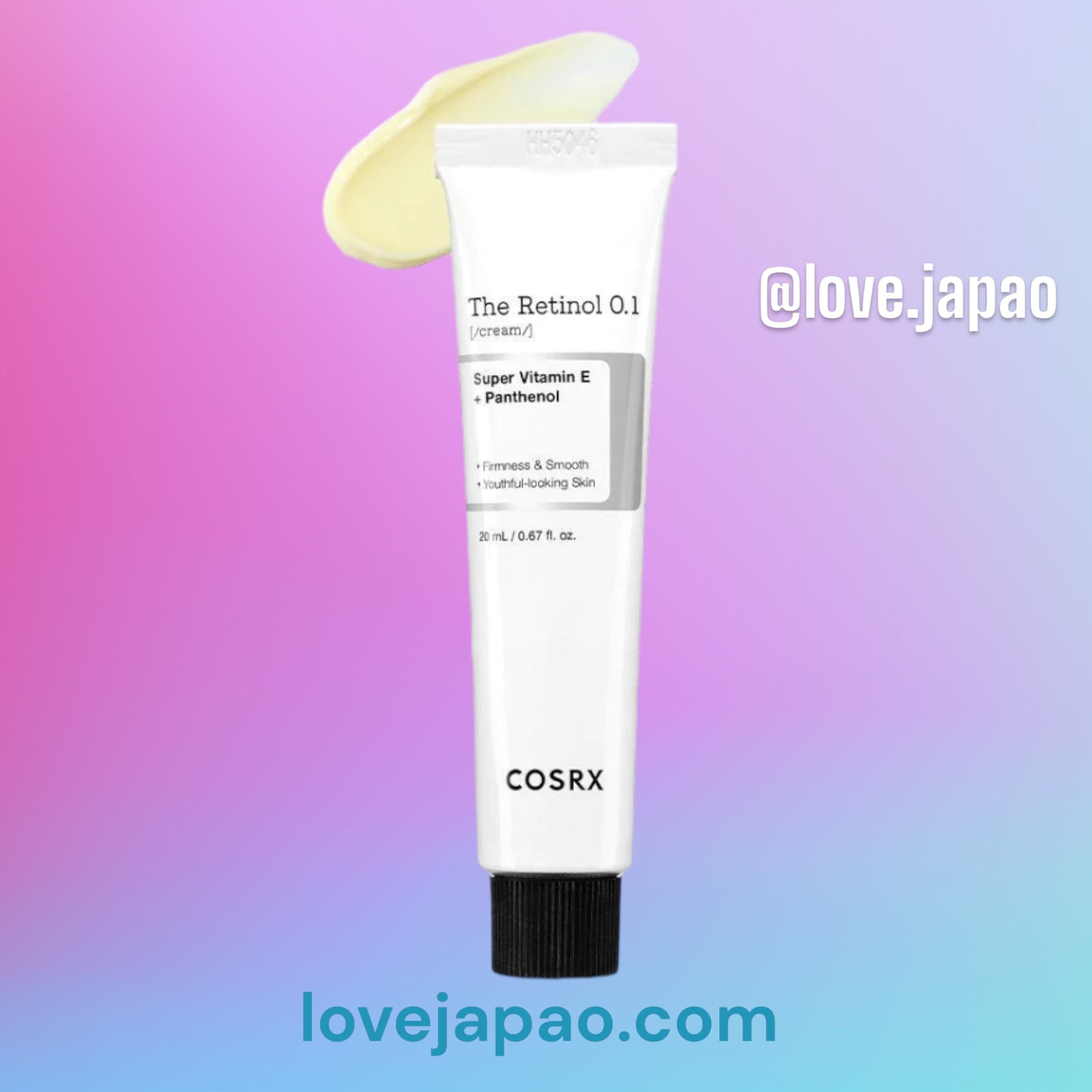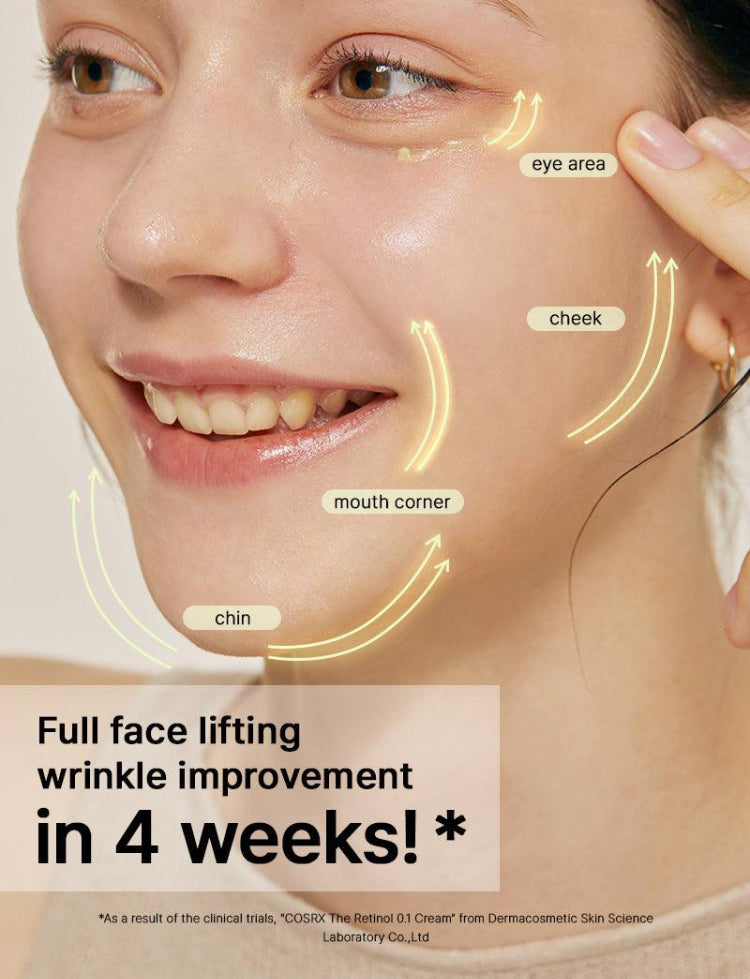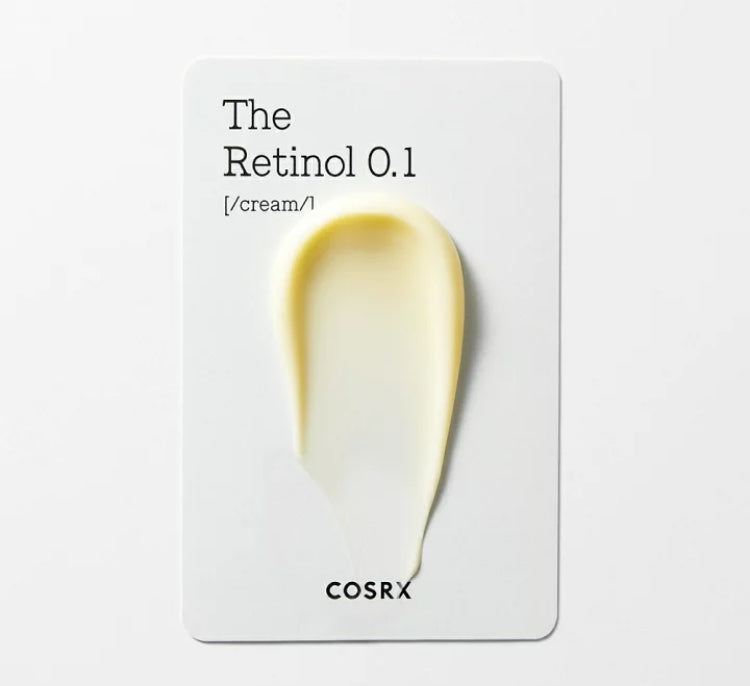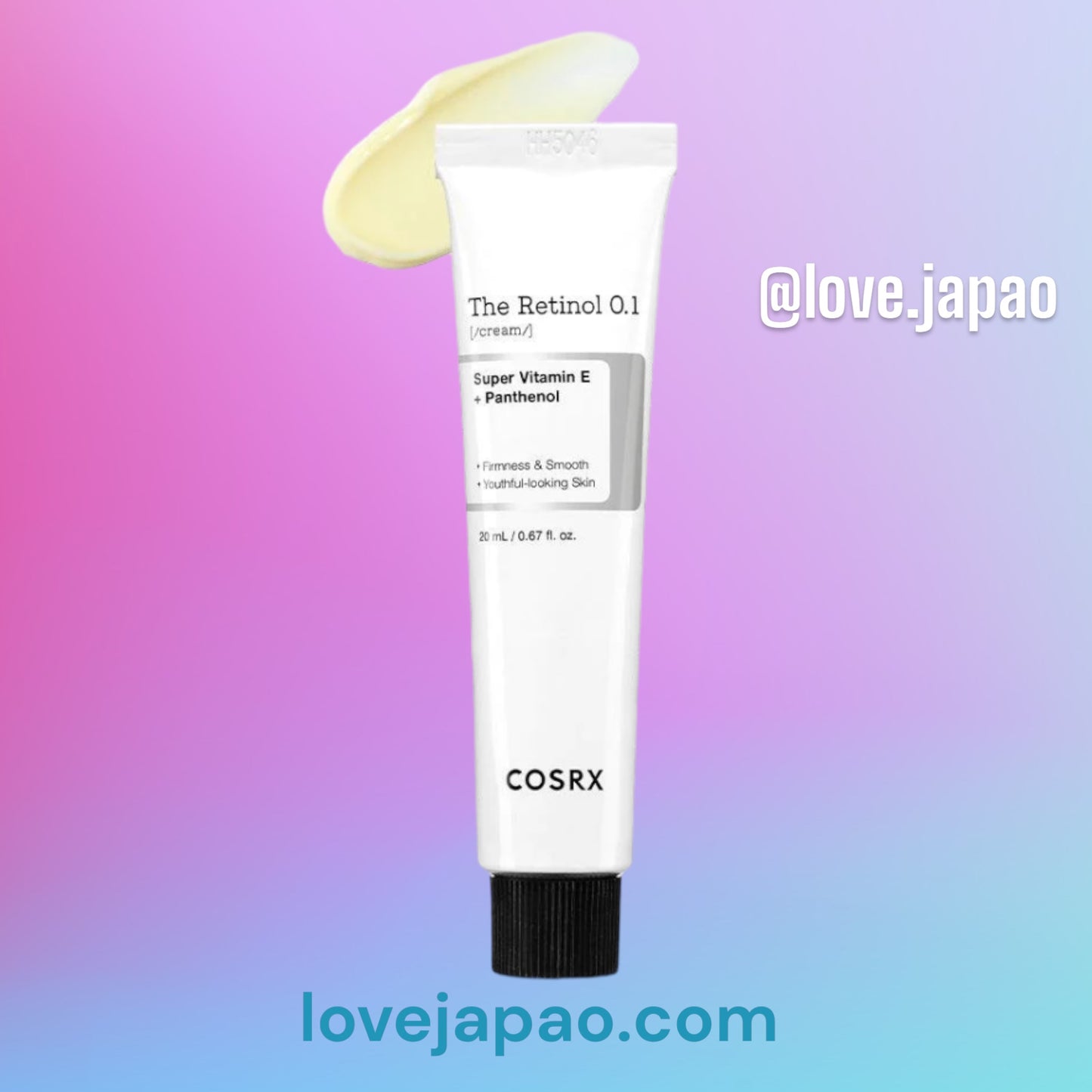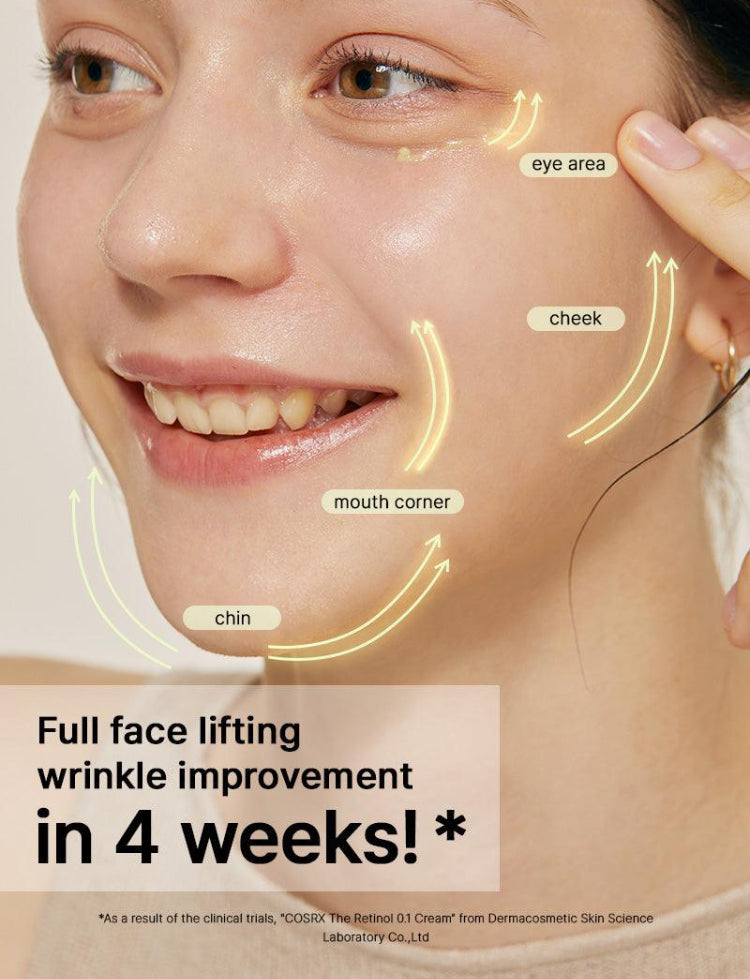Low irritation with 0.1% pure retinol
An irritation-reducing solution created with the ideal ratio of essential ingredients for first-time retinol users who are beginning to notice the appearance of fine lines caused by dry skin. The perfect choice to prevent and correct the first signs of aging before they take hold.
Solution for a youthful, radiant complexion!
Clinical results in 4 weeks
*Suitable for use on acne-prone skin (non-comedogenic).
- 18.62% improvement in wrinkles (forehead)
- 18.32% improvement in wrinkles (nasolabial)
- 16.25% improvement in wrinkles (eye area)
- 12.81% improvement in elasticity (external elasticity)
- 12.66% improvement in lifting (corner of the mouth)
- 10.30% improvement in elevation (chin)
- 4 .16% improvement in skin age
Clinical results in 2 weeks
- 45.14% pore (volume) improvement
- 42.07% pore (area) improvement
*Based on clinical trials of 20 subjects.
*Dermacosmetic Skin Sciences Laboratory Co., Ltd.
• Pure Retinol (Vitamin A):
Diminish wrinkles and fine lines
*Learn more about Retinol →Retinol, also known as vitamin A, is one of the representative fat-soluble vitamins and has been used in skin care for a long time. This time, we would like to easily inform people about retinol which we hear a lot but it is still difficult. Prolonged exposure to ultraviolet rays can lead to the decrease of collagen, elastin, hyaluronic acid, etc., which are essential elements that make up the skin , and retinol can fill in skin that becomes hollow and improve elasticity and wrinkles by promoting the synthesis of diminished components in the skin. Premature aging slows down the rate at which new keratin cells are formed, which also slows down cell shedding keratin turnover as the skin turnover cycle lengthens, and retinol can eliminate dead skin cells and improve skin texture by promoting new keratin cells to normalize the turnover cycle.
Increased sebum production in pores results in skin problems such as acne, and retinol can not only improve skin problems, but also improve hyperpigmentation caused by skin problems by reducing sebum to suppress the spread of acne. sebaceous cells.
[Reference] Effects of 13-cis-retinoic acid, all-trans-retinoic acid and acitretin on proliferation, lipid synthesis and keratin expression of human sebocytes cultured in vitro, J Invest Dermatol. 1991, 96(5):792-7.
[Reference] An advanced, medical-strength retinol peel improves signs of aging and acne in a variety of skin types, including melasma and skin of color, JDD, 2019 , 1;18(9):918-923.
▶ Features of Retinol
As explained earlier, retinol has been used as a skin care ingredient for a long time due to its excellent effectiveness for the skin. However, it is relatively difficult to obtain high concentrations of retinol because it is unstable against ultraviolet rays and the higher the retinol content, the lower the stability. To solve this unstable problem, not only the development of various retinol derivatives, but also techniques for stabilizing retinol are constantly being studied.
[Reference] UV Irradiation and Cutaneous Vitamin A: An Experimental Study in Rabbit and Human Skin, J. Invest. Dermatol. 83, 401–404.
- Retinol and retinol derivative
Retinol derivatives are known to be converted to retinol through certain chemical reactions and enzymatic actions and can cause effects on the skin. However, it is a little difficult to be sure that retinol derivatives have the full effect of retinol, as it is not clear how much can be converted to retinol in our skin and by what action.
[Reference] Unoccluded retinol penetrates human skin in Vivi more effectively than unoccluded retinyl palmitate or retinoic acid, Journal of Investigative Dermatology, Vol 109(3), 1997, 301-305
In fact, in Korea, retinol and retinyl palmitate (retinol derivative) are included as notification ingredients from the Ministry of Food and Drug Safety that prove to be effective in improving wrinkles, and the content of notification of these two ingredients is 4 times different.
In simple language, it means that the retinol derivative needs at least 4 times the amount of retinol to obtain the certification of wrinkle improvement effect in Korea.
- Retinol and retinal
Recently, an ingredient called “Retinal” is also used in cosmetics, but the ingredient that has long been studied for skin effectiveness is known as retinol. Therefore, the most recommended ingredient for adequate effectiveness is retinol.
- Skin reactions and precautions for use
The use of retinol can cause skin reactions that are not easily seen with other ingredients. Depending on the skin type, skin reactions such as stinging, burning, skin peeling and redness may occur. These skin reactions are phenomena that can occur when retinol acts effectively on the skin. This is not a phenomenon that occurs in all skin types and may disappear after a period of adaptation. It is recommended that you pay more attention to your skin condition when using retinol.
However, in the case of pregnant and breastfeeding women, it may cause side effects to the fetus, so avoid using it during this period.
Increased sebum production in pores results in skin problems such as acne, and retinol can not only improve skin problems, but also improve hyperpigmentation caused by skin problems by reducing sebum to suppress the spread of acne. sebaceous cells.
[Reference] Effects of 13-cis-retinoic acid, all-trans-retinoic acid and acitretin on proliferation, lipid synthesis and keratin expression of human sebocytes cultured in vitro, J Invest Dermatol. 1991, 96(5):792-7.
[Reference] An advanced, medical-strength retinol peel improves signs of aging and acne in a variety of skin types, including melasma and skin of color, JDD, 2019 , 1;18(9):918-923.
▶ Features of Retinol
As explained previously, retinol has been used as a skin care ingredient for a long time due to its excellent effectiveness for the skin. However, it is relatively difficult to obtain high concentrations of retinol because it is unstable against ultraviolet rays and the higher the retinol content, the lower the stability. To solve this unstable problem, not only the development of various retinol derivatives, but also techniques to stabilize retinol are constantly being studied.
[Reference] UV Irradiation and Cutaneous Vitamin A: An Experimental Study in Rabbit and Human Skin, J. Invest. Dermatol. 83, 401–404.
- Retinol and retinol derivative
Retinol derivatives are known to be converted to retinol through certain chemical reactions and enzymatic actions and can cause effects on the skin. However, it is a little difficult to be sure that retinol derivatives have the full effect of retinol, as it is not clear how much can be converted to retinol in our skin and by what action.
[Reference] Unoccluded retinol penetrates human skin in Vivi more effectively than unoccluded retinyl palmitate or retinoic acid, Journal of Investigative Dermatology, Vol 109(3), 1997, 301-305
In fact, in Korea, retinol and retinyl palmitate (retinol derivative) are included as notification ingredients from the Ministry of Food and Drug Safety that prove to be effective in improving wrinkles, and the content of notification of these two ingredients is 4 times different.
In simple language, it means that the retinol derivative needs at least 4 times the amount of retinol to obtain the certification of wrinkle improvement effect in Korea.
- Retinol and retinal
Recently, an ingredient called “Retinal” is also used in cosmetics, but the ingredient that has long been studied for skin effectiveness is known as retinol. Therefore, the most recommended ingredient for adequate effectiveness is retinol.
- Skin reactions and precautions for use
The use of retinol can cause skin reactions that are not easily seen with other ingredients. Depending on the skin type, skin reactions such as stinging, burning, skin peeling and redness may occur. These skin reactions are phenomena that can occur when retinol acts effectively on the skin. This is not a phenomenon that occurs in all skin types and may disappear after a period of adaptation. It is recommended that you pay more attention to your skin condition when using retinol.
▶ Tips for adapting to Retinol
It is important that the use of a product containing a high concentration of retinol is necessary to go through a guided adaptation process.
During the adaptation period, you may experience temporary skin reactions such as tingling, redness, peeling, etc., or no skin reaction at all.
Even if there is no skin reaction upon first use, it is recommended to use according to the instructions for use at the beginning as you may experience an adaptation reaction later. If retinol sensitive reaction continues after the adaptation period, it is better to gradually increase the usage amount and usage cycle considering the skin condition, rather than increasing it all at once.
If your skin is sensitive to reactions, it may be helpful to use 「The 6 Peptide Skin Booster Serum」 or 「The Hyaluronic 3 Serum」 before using retinol.
Retinol is an ingredient that is unstable to ultraviolet rays, so it is recommended to use it at night and use sunscreen during the day during the period of use.
• Panthenol:
Protects and hydrates the skin from external stimuli
• Adenosine:
Activation of skin cells. Improves elasticity and wrinkles
• Tocotrienol (Super Vitamin E):
Reduces visible signs of aging and skin damage
Water, caprylic/capric triglyceride, propanediol, glycerin, tocopheryl acetate, cetearyl alcohol, trehalose, panthenol, Butyrospermum Parkii (Shea) butter, glycine soya (soy) oil, ammonium acryloyldimethyltaurate/VP copolymer, dimethicone, polymethacrylate of glyceryl, Helianthus Annuus (sunflower).) Seed Oil, Polyglyceryl Stearate-10, Hydrogenated Lecithin, Hydroxyethyl Acryloyldimethyl Taurate Copolymer, Carbomer, Tromethamine, Glyceryl Stearate, Polysilicone-11, Sodium Sulfite, Tocopherol, Daucus Carota Sativa (Carrot) Root Extract, Retinol (0.1%), allantoin, glyceryl caprylate, Oryza Sativa (rice) bran wax, tocotrienols, stearic acid, polyglyceryl-3 methylglucose distearate, palmitic acid, disodium EDTA, ethylhexylglycerin, adenosine, sorbitan isostearate, Elaeis Guineensis (Palm) Oil, BHT, Beta-Carotene, Myristic Acid, Lauric Acid, Ascorbic Acid, Limnanthes Alba Seed Oil (Meadowfoam), 3-O-Ethyl Ascorbic Acid, Glutathione, Sodium Hyaluronate, 1.2 -Hexanediol, Hydrolyzed Hyaluronic Acid, Sodium Hyaluronate Crosspolymer, Hyaluronic Acid, Acetylated Sodium Hyaluronate
